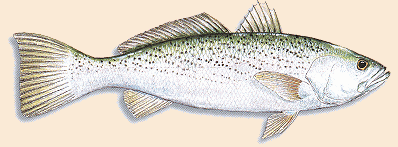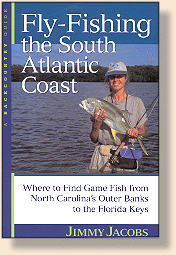Spotted Seatrout (Cynoscion nebulosus)
. . . Among all fishermen along the South Atlantic Coast
spotted seatrout have been the number one target for years.
Their populariety is founded on their abundance, wide range,
and willingness to strike a variety of baits and lures, plus
their fine taste (although they do not freeze well and should
be eaten fresh). These fish are sometimes called speckled
trout, specks, or simply trout by the anglers who target them.
Larger specimens of this species are sometimes called yellowmouths
because of the color around their mouths.
Spotted seatrout are found all along the southern Atlantic
seaboard, from North Carolina's sounds to the Florida Keys.
Throughout this range they can be found along beaches,
particularly in the fall and winter, but are much more abundant
in tidal creeks, rivers, and bays. They are common on shallow
sea-grass flats as well. With the exception of some migratory
fish that move south from Chesapeake Bay into the Carolinas in
the winter, seatrout are relative homebodies. Research has
found that they spend most of their lives within a mile or two
of the estuary where they were spawned.
Though there are several related species that resemble this rather
slender-framed member of the drum family, the seatrout's hallmark
sports make it easily identifiable. These round black spots occur
in random patterns along the back and sides of the fish, and are
also found on the tail and dorsal fin.

The very similar weakfish [shown above] is also found along the South Atlantic
Coast and is the fish most commonly confused with the seatrout.
The weakfish, however, has only faint speckles on its sides and
no spots at all on its tail or fins.
Throughout its range the spotted seatrout is abundant in sizes of
up to 6 pounds. Any fish larger than this is considered a trophy
catch and is often referred to as a "gator trout." In the
southernmost portion of the waters inhabited by seatrout - and
particularly in Florida's Indian River Lagoon in the vicinity of
Cocoa, Melbourne, and Vero Beach - fish of more than 10 pounds
are taken regularly. The all-tackle world record for this species
is held by Craig F. Carson for a 17-pound, 7-ounce spotted seatrout
caught at Fort Pierce, Florida, on May 11, 1995.
Speckled trout are excellent quarry to challenge with a fly-rod.
They readily attack brightly colored streamers; many fly-casters favor
red-and-yellow or red-and-white color combinations. But seatrout will
strike any number of fly hues, particularly when they are actively
feeding. These fish feed at varying depths, from the bottom to the
surface, making it possible to attract them to topwater popping
bugs in a variety of colors.
Seatrout do show a preference for a fly that is retrieved slowly,
whether a streamer or a popping bug. When you spot a fish
approaching your fly, however, you should speed up your retrieve
to resemble a fleeing baitfish. Seatrout are noted for their
proclivity for making quick dashes at a fly near the boat or shore,
just as an angler is about to pick it up for a new cast.

In spite of their following among anglers, seatrout are not particularly
impressive fighters once hooked. They are more prone to thrash on the
surface than to make strong runs or leap from the water. They must
be played with care as well, since their mouths are notoriously soft,
making it easy for hooks to pull loose. The popularity of spotted
seatrout is built on their abundance and edibility rather than their
ferocious nature. ~ Jimmy Jacobs
Credits: Excerpt from Fly-
Fishing the South Atlantic Coast by Jimmy Jacobs,
published by Backcountry, an imprint of Countryman Press.
Fish illustrations from Sport Fish of Florida
by Vic Dunaway, published by Florida Sportsman.
|



